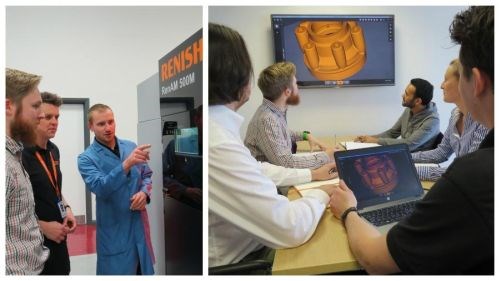How Renishaw Is Lowering Barriers to Additive Manufacturing
The company wants to help manufacturers prove out designs and processes for part production via additive manufacturing.
Share






Users at the Solutions Centers will get support for their projects from Renishaw applications engineers. Images courtesy of Renishaw.
The barriers to using additive manufacturing (AM) technology for production are physical—having the right equipment, software, etc.—but also largely mental. Engineering a part for additive manufacturing requires a different way of thinking about strength, material usage, finishing and more, especially for users and companies coming from a machining background. Using AM for production also demands confidence in the process, and that it will be repeatable and consistent.
As a way of helping new and potential additive users overcome these hurdles and learn to think with an “AM mindset,” Renishaw has launched its Solutions Center concept. Unveiled at EMO last year, the concept is a global network of facilities intended to help potential and current additive manufacturing users learn about the technology. Users can work within an “incubator cell” staffed with an operator and applications engineer to securely benchmark designs and test out processes. The goal is to help users develop a complete process for manufacturing production parts.
The first Solutions Center in Pune, India, is already open for business and is said to be India’s largest additive manufacturing facility. Additional centers are currently under construction in the United Kingdom, the United States, Canada and Germany.
Read more about the goals and progress of the Solutions Center network on Additive Manufacturing magazine’s website.
Related Content
-
Designing a 3D Printed Part with Machining in Mind
Designing extra stock and mounting features into a 3D printed part can aid in machining processes downstream.
-
A Fond Farewell to My Additive Friends
In his final “Additive Insights” column, Tim Simpson reflects on how additive manufacturing has progressed in the last six years. Standards and software are two examples.
-
Additive/Subtractive Hybrid CNC Machine Tools Continue to Make Gains (Includes Video)
The hybrid machine tool is an idea that continues to advance. Two important developments of recent years expand the possibilities for this platform.

.jpg;width=70;height=70;mode=crop)



















